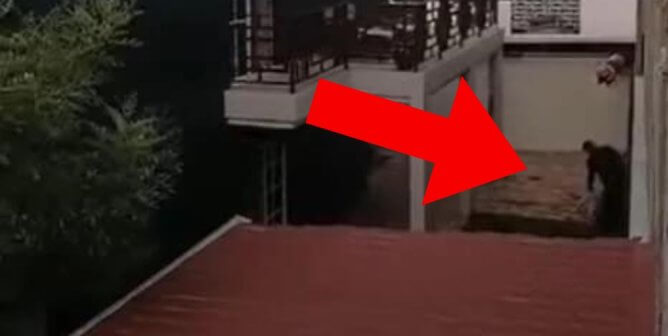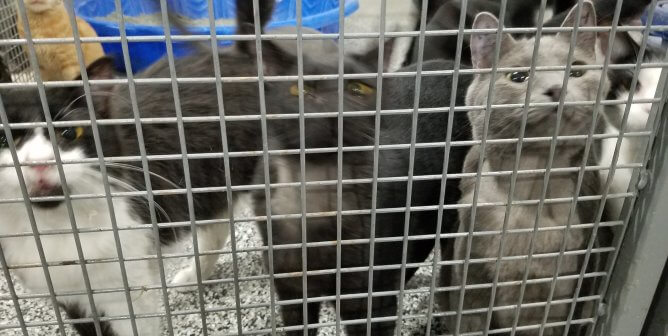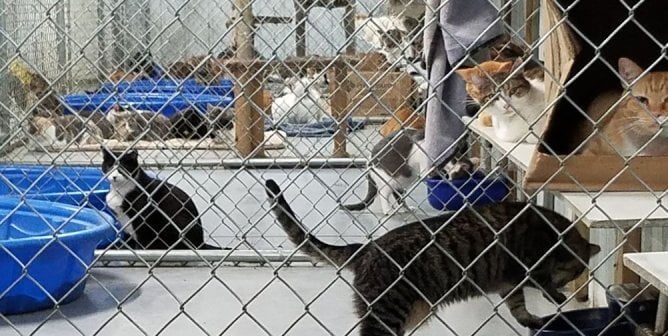Homeless Cats: Trapping Is the Kindest Solution
It is estimated that more than 60 million homeless cats are roaming the parks, parking lots, backyards, alleys, and streets of America. Although so-called feral cats—who have not been socialized and who are often the offspring of other abandoned cats—are fearful of humans, they are still domesticated animals who struggle to fend for themselves and don’t survive for long on their own. Homeless cats do not die of “old age.” Many are tortured by cruel people, attacked by other animals, or hit by cars. Others die of exposure, starvation, or highly contagious fatal diseases, such as rabies, feline AIDS, feline leukemia, and feline infectious peritonitis.
Victims of Humans and Nature
Many people consider homeless cats a “nuisance” for digging in their flowerbeds, seeking shelter under their porches, or climbing on their cars. Some may take matters into their own hands by shooting, drowning, poisoning, or otherwise killing cats in cruel ways. In Kentucky, several cats described as “neighborhood cats” died from apparent poisoning, and another died after being beaten to death or hit by a car.1 A cat in Massachusetts who was described as “a barn cat” was found “screaming” and “dragging himself home” after becoming trapped in a snare that was constricting his stomach. His mouth was lacerated from trying to chew the wire off.2 A surveillance camera at a school in California captured footage of a man torturing and killing a cat by “kicking and punching” the animal and dragging him or her by a rope.3 These are only a few examples of the myriad horrible injuries and deaths that outdoor cats must face.
Even easily treatable conditions can be deadly for cats who are not afforded basic veterinary care. Minor cuts or puncture wounds can turn into raging infections and abscesses. Untreated upper-respiratory infections cause cats’ eyes and noses to become so caked with mucus that they can barely see or breathe. Cats often scratch their ears until they bleed, because they’re driven mad by the pain and itching of ear mites and related infections. Others die of blood loss or anemia because of worms or fleas. Urinary tract infections, which frequently lead to urinary blockages in male cats, cause slow and extremely painful deaths if they go untreated.
Also, outdoor cats pose a threat to wildlife. The journal Nature Communications reports that domestic cats “have been listed among the 100 worst non-native invasive species in the world.”4 In addition to killing up to 4 billion birds and 22 billion mammals every year, “free-ranging cats have caused or contributed to 33 (14%) of the modern bird, mammal and reptile extinctions.” An Australian study found that free-roaming cats kill at least a million birds a day there, and the lead researcher concluded that “the amount of predation is staggering, and is likely to be driving the ongoing decline of many species.”5
Cats Can’t Live on ‘Bread’ Alone
It’s not enough merely to feed cats without capturing them to ensure their safety: This can actually make the situation worse. Just feeding colonies of homeless cats means that they will give birth to more kittens, who are destined to suffer and die painful deaths, too. It is essential to get these animals off the streets in order to prevent them and their offspring from suffering. Feeding should only be seen as a prelude to trapping, as a way of getting cats accustomed to eating in a certain place at a certain time. Otherwise, feeding just serves to help homeless cat populations proliferate.
Trapping Do’s and Don’ts
Before trapping any cats, obtain written permission from the owner of the property on which they congregate. Wear thick gloves if you plan to handle kittens or cats, as unsocialized or frightened cats can easily injure you (or themselves). Be gentle: Even humane (box) traps terrify animals who feel vulnerable and defenseless when confined.
Line the bottom of the trap with a thick piece of cloth, a folded newspaper, or an old towel. Make sure it does not interfere with closing the door or the trap’s spring mechanism. The animal will feel more secure walking in without walking on wire, and will be afforded a small measure of comfort. Do not use the same towel or cloth again for the same purpose unless you have thoroughly washed it—animals are very sensitive to smells and may be apprehensive.
Do not set a trap and then leave it unattended, even for a few minutes. Anything could happen while you’re away. Set your trap, then back off, but stay within sight of it. Be patient. Plan to do your trapping when you have enough time to wait. Avoid trapping in bad or extremely hot weather. Cats are most likely to be out and about during early-morning or late-evening hours.
Place the trap on firm, level ground so that it does not wobble when touched. Orient it in such a way that when the cats enter, they can keep an eye on you or whatever danger that they would rather not turn their backs on.
Create a small trail of food that runs from outside the trap all the way inside toward a large pile of food at the very back. Use smelly food as bait, and place it on a paper plate or a piece of newspaper. Avoid putting it in a container as trapped animals may initially thrash once the door closes, and a container could cause injury.
Immediately after the cat enters the trap, cover it with a towel or a blanket (in cold weather) or a sheet (in hot weather). Trapped animals calm down more quickly when they are covered. Be sure they can breathe freely.
Gently carry the trap to your vehicle with both hands. The cat will be frightened, so be aware that even small movements or noises can cause additional stress. Don’t slam doors or play loud music. Be careful not to swing the trap from side to side or tilt it as you walk or turn.
Always use a vehicle. Even if the animal you want to trap is only a few blocks away, drive or have a friend drive you to the site in order to limit the distance the trap must be carried. This is the safest and the least stressful way to handle it for all involved.
Decide ahead of time where you will take the cat, and make arrangements ahead of time. Never assume that the animal will be accepted as a walk-in. If you plan to try to rehabilitate and adopt out the cat, it is best to take him or her straight to a veterinarian to be spayed or neutered, vaccinated, tested for feline leukemia and feline AIDS, and treated for worm and flea infestations.
If it isn’t possible to take the cat directly to a veterinarian or an animal shelter, transfer him or her to a larger carrier that’s equipped with a litter pan, food, and water by putting the open carrier next to the trap and opening the trap door. Never turn unsocialized cats loose in the house—you may not see them again for days, and it may be difficult to trap them again when you’re planning to take them to a veterinarian or an animal shelter.
After bringing cats home from the vet, put them in a quiet room separated from other animals for a week or two; this will allow them to recover from surgery and become accustomed to their new surroundings. When the cats have recuperated, they can be released into the house (never allow any cat outside). Be patient: If they are truly feral, it may take months (or years) of kindness for them to trust you. However, many homeless cats are not feral at all: They are friendly animals who are simply frightened and can come around fairly quickly.
Because of the huge number of homeless cats and the severe shortage of loving, committed homes, the difficulty of socialization, and the dangers lurking where most unsocialized cats live, it is sometimes necessary—and compassionate—to have feral cats euthanized. You can ask your veterinarian to help or, if your local animal shelter euthanizes via an injection of sodium pentobarbital, take the cats there. Please do not allow the prospect of euthanasia to deter you from trapping homeless cats. If you leave them where they are, they will certainly die a prolonged and painful death. A painless death is far kinder than the fate that homeless cats will meet if left to fend for themselves.
Where to Get a Trap
If your local animal shelter can’t lend you a box trap, invest in one of your own. Cat traps typically cost about $40 to $50 and are available online or at most hardware and feed-and-seed stores.
References
1Steve Rogers, “Frankfort Police Open Criminal Investigation Into Cat Deaths,” WTVQ.com, 30 Sept. 2020.
2Christine McCarthy, “Norton Family’s Cat Injured by Illegal Wire Snare Trap,” Boston25News.com, 30 Sept. 2020.
3“Esparto Man Arrested on Suspicion of Animal Cruelty,” DailyDemocrat.com, 30 Sept. 2020
4Scott R. Loss et al., “The Impact of Free-Ranging Domestic Cats on Wildlife of the United States,” Nature Communications, 29 Jan. 2013.
5Lia Eustachewich, “Feral Cats Are Driving Some Birds to the Brink of Extinction,” New York Post, 4 Oct. 2017.







